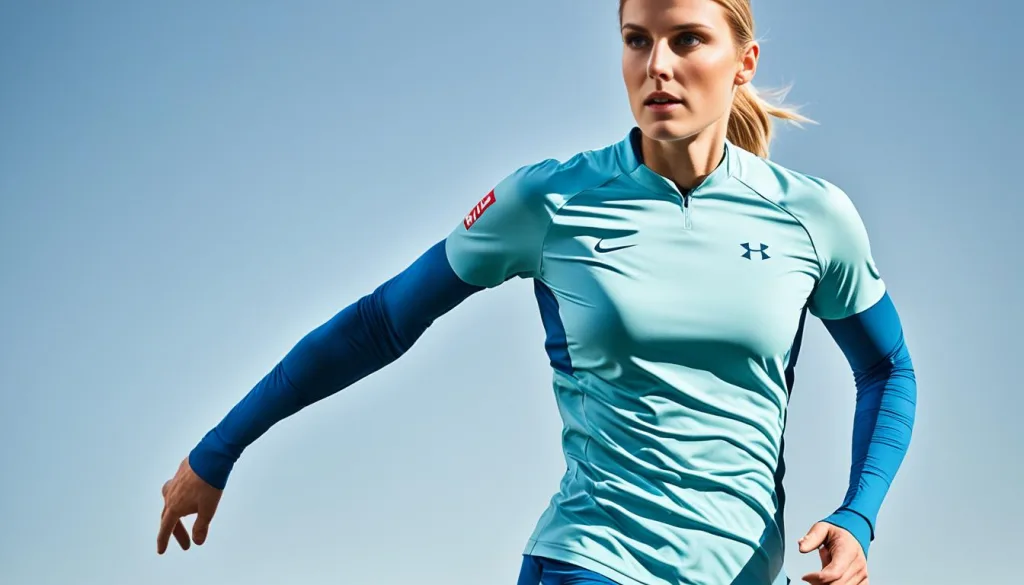Navigating the Complexities of Sportswear Patents and IP Rights
Connect With Us Today
Consider us for your next production run. Why wait? Send us your questions here.
In the world of athletic wear, protecting sportswear designs with patents is crucial. Companies like Nike set an example with their Flyknit technology. They show that owning intellectual property for sportswear leads to innovation and being a leader1. Nike filed nine patents for Flyknit, proving their dedication to patenting sportswear innovations1.
But, the world of IP rights in sportswear is filled with challenges. Legal battles over intellectual property show how vital it is to secure your place in the market1.
Key Takeaways
- Understanding the value of sportswear patents is key to industry dominance.
- IP rights in sportswear fortify a brand’s unique innovations and market presence.
- Legal complexities in sportswear trademark protection can affect market strategy.
- For iconic innovations like Flyknit, legal protection for sportswear designs is essential for maintaining competitive advantage.
- Implementing a robust sportswear IP strategy can lead to securing brand loyalty and consumer trust.
- While protecting sportswear designs is vital, it can lead to high-stakes legal challenges.
- Due diligence in navigating sportswear IP can prevent costly litigation and safeguard innovation.
The Strategic Litigation Chessboard of Global Sportswear Giants
In the world of sportswear, big names clash not just in design but in court too. Companies like Nike take legal action to protect their new tech fiercely. This shows how vital patents, like the Flyknit, are to stay ahead.
Safeguarding Technological Innovations: The Case of Nike’s Flyknit
Nike’s Flyknit tech has changed shoes with its light, snug fit. Facing off against New Balance and Skechers, Nike makes it clear they’ll guard their inventions. This shows how key patents are in the sportswear world.
It’s not just about one item but protecting all sportswear patents. Fights with Adidas and Puma weren’t just about looks but about protecting the core of Flyknit’s innovation. Nike’s legal tussle with Lululemon also highlights this battle in patents.
Patent laws were made to encourage new inventions. The first patent law dates back to Venice in 14742. The idea of protecting creative works has evolved since then, aiming to spur on more innovation.
But, patents have a time limit, usually 20 years3. The Patent Cooperation Treaty helps make filing patents easier worldwide3. This is crucial for companies wanting to protect their new tech.
WIPO plays a huge role in this global game by helping set up laws and support innovators, especially in developing nations23. New tech helps make sharing and searching for patents faster3.
The battles of the sportswear giants, like Nike’s for Flyknit, show the challenge of keeping innovations safe. These fights stress the need to understand and navigate patent protections.
Intellectual Property Essentials for Sportswear Fashion
IP law in the sportswear sector protects creativity and boosts economic growth. It has scored wins like patent protection for a media company against a challenger, safekeeping the rights to five patents4. The fast resolution of a trademark dispute between stores in New York and Georgia shows how effective this legal system is4.

Respecting trademark and dress rights in a $30M fake case protected design integrity. This highlighted the importance of keeping IP in sportswear safe4. Relief granted to a switch maker from patent charges highlights IP law’s detailed use4. Legal battles, like those for power equipment, end in settlements that emphasize the need for various patents4.
The Role of IP Law in Fostering Innovation and Economic Growth
IP law doesn’t just fight lawsuits. It also opens up ways to make money. For example, sports memorabilia bring in about $5.4 billion a year5. Sport NFTs are expected to make over $2 billion in 2022. The NFT market might reach $75 billion by 20255. Nike and NASCAR’s early trademarks for virtual items show they know the importance of new markets5.
| IP Component | Industry Impact | Representative Cases |
|---|---|---|
| Trademark Protection | Essential for branding and preventing unauthorized use | Washington Football Team v. Pro-Football, Inc. (2020)6 |
| Patent Protection | Secures innovations, critical for technological advances | Nike, Inc. v. Adidas AG (2012)6 |
| Copyright and Trademark Enforcement | Bolsters revenue, combats counterfeiting, and sustains market share | Michael Jordan’s lawsuit against Qiaodan Sports Co. (2016)6 |
As athletes and creators embrace NFTs, IP questions arise. They explore the limits of trademark use online5. The Premier League’s fight against pirated broadcasts shows the need for strong IP strategies in sports6.
Navigating the Complexities of Sportswear Patents and IP Rights
In the world of sportswear patents and IP rights in sportswear, brands are in a high-stakes race. They fight to shield their creative work and push boundaries. With every step into the legal arena of sportswear IP, they face intense rivalry and intricate challenges. The heart of sports law strengthens their efforts, touching on intellectual property and more7. To win here, protecting your design and tech breakthroughs is as much about strategy as it is about law.
For brands aiming to lead, understanding sportswear IP’s full scope is crucial. This field spans many areas, including contracts, doping rules, athlete safety, and crucially, intellectual property rights7. The strength of patent protection in sportswear keeps the playing field level and ethical. It’s central to upholding honor and fairness in sports7.

The role of legal safeguards is immense, especially as sports law adapts to new challenges, guiding the sports world onward7. Sports lawyers stand as vital allies. They work tirelessly to protect a wide array of clients, from individual players and teams to large organizations7.
Having a strong patent collection is key for brands eager to succeed in this arena. Sportswear law fuels their journey from start to finish:
- Laws pave the way for sports to grow professionally and commercially over time7.
- They delve into contract details and promote fair competition in a growing global market7.
- Sports law does more than solve disputes; it underpins the ethical and functional structure of sports7.
Thinking about sportswear patents and IP rights, we see it’s not just about court battles. It’s also about smart planning. Brands need to safeguard their innovations against history, policy, and business trends7.
Drawing the Battle Lines: Competition and Consumer Trends in Sportswear
In sportswear, it’s not just about big ads. It’s about catching and moving with consumer trends in sportswear and global supply chain dynamics. Brands are always tweaking their plans to keep up. They’re blending sustainability in sportswear and technological integration too. These steps help win over picky shoppers.
Market Dominance Strategies and Product Differentiation
To stay ahead in sportswear market competition, companies need smart plans. They focus on product differentiation. Brands stand out by mixing unique styles or features with cultural truth. This way, they connect better with customers.
Today, being aware and careful about cultural values is key. Brands reevaluate their design sources to avoid cultural missteps.
This was clear when a sportswear firm faced backlash in 2013. Their leggings had Samoan tattoo designs meant for men, which upset many8. Similarly, there were issues with shoes themed after mola art, wrongly linked to Puerto Rican culture8. There was also a UK label that copied Inuit parka designs. They had to pull back their line after protests8.
Current laws don’t protect traditional cultural expressions well, letting them be wrongly used8. Organizations like WIPO Intergovernmental Committee (IGC) are working on better laws8. Indigenous designers are leading the way. They create clothes that truly show their culture’s beauty8.
The sportswear industry is facing high costs. Brands must offer new, responsible designs without overpricing. They need to balance respect for cultures, innovation, and sustainability. This blend can strengthen their ties with customers and make them ethical fashion leaders.
| Year | Brand | Incident | Outcome |
|---|---|---|---|
| 2013 | Nike | Leggings with Samoan Pe’a Tattoo | Public outcry, product withdrawal, apology issued |
| 2015 | KTZ | Inuit Parka Design on Sweater | Sweater removal from sale, apology issued |
| 2019 | Nike | “Air Force 1 Puerto Rico” | Launch cancellation due to cultural misattribution |
Conclusion
Reflecting on the importance of protecting intellectual property in sportswear shows it’s more than legal stuff. It’s key for strategy. Nike has shown this by securing the Flyknit technology with nine patents. This move isn’t just about legal rights; it’s about keeping ahead of copycats1. They fight against fake goods and sue rivals like New Balance and Skechers to protect their innovations1. This tough defense boosts their reputation and fuels the innovation that fans love.
Dealing with IP challenges in sportswear means always being ready and spotting new trends1. The fight with Lululemon shows the tough world these companies live in. Design patents highlight a brand’s unique look, pushing innovation and competition in the industry1.
Companies must stay quick on their feet with their IP plans. Looking at the future, the industry will keep creating new, exciting sports clothes. They use both legal smarts and creativity to lead the way in sportswear.
FAQ
What is the role of intellectual property in the sportswear industry?
What types of patents apply to sportswear fashion?
How can companies navigate the complexities of sportswear patents and IP rights?
What are some market dominance strategies in the sportswear industry?
Why is intellectual property protection important in the sportswear industry?
Source Links
- https://www.sportsbusinessjournal.com/Articles/2024/04/10/oped-10-romero
- https://en.wikipedia.org/wiki/Intellectual_property
- https://www.wipo.int/patents/en/
- https://www.aipla.org/docs/default-source/adr-neutrals/powell_michaelj-cv.pdf
- https://digitalcommons.law.villanova.edu/cgi/viewcontent.cgi?article=1422&context=mslj
- https://www.theippress.com/2023/12/04/navigating-the-playing-field-the-impact-of-intellectual-property-law-in-the-sports-industry/
- https://www.lexinter.net/law/sports
- https://www.wipo.int/wipo_magazine/en/2019/04/article_0002.html
Latest News
How Collaboration Shapes Consumer Preferences in Sportswear
Navigating Consumer Rights and Warranties in Sportswear Sales
Artificial Intelligence in Fashion Forecasting and Trend Analysis
The Shift Towards Inclusive Sizing in Sportswear: Consumer Reactions
The Global Expansion of Luxury Sportswear Brands
From Sketch to Gym: The Design Process of Fashionable Sportswear
Understanding the Role of Trade Associations in Sportswear Compliance
How Economic Trends Influence Consumer Spending on Sportswear
Learning from Successful Global Market Entries
Best Practices for Managing Cross-Cultural Teams
Using Technology to Fight Counterfeit Fashion Products
Carbon Nanotube Fabrics for Superior Strength and Flexibility
The Growth of Fitness Tracking Apparel in Health and Wellness
Exploring the Influence of Social Proof in Sportswear Purchasing
Strategies for Managing Compliance in a Multinational Operation
Trends in Global Footwear: Performance Meets Lifestyle
The Role of Artificial Intelligence in Tracking Supply Chain Operations
Evaluating the Success of Sportswear Collaborative Projects
Evaluating the Potential of Emerging Markets
Global Shifts Towards Gender-Neutral Sportswear
Share This Article
Latest Articles



















